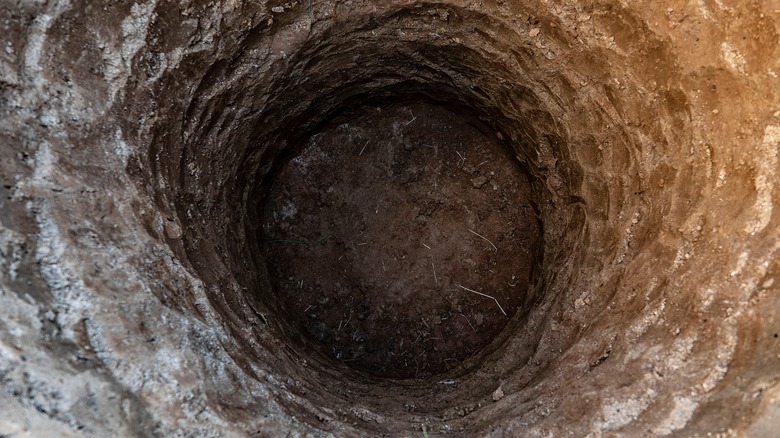The Conspiracy Theory That Might Explain The Oak Island Mystery
Often referred to as "the world's longest and most expensive treasure hunt," the Oak Island mystery has fascinated people for generations (per The Skeptical Inquirer). The privately owned 140-acre island off the coast of Canada's province of Nova Scotia is said to be home to a magnificent treasure, buried at the bottom of a mysterious shaft (via Tourism Chester). Known as the "Money Pit," the deep shaft is said to hold gold, silver, or even Biblical treasures, depending on who you ask. Attempts to find the treasure date back over a century, though the search has ramped up significantly since the 1960s, when crews started arriving with more advanced machinery (rather than using horse-driven equipment).
According to a 1965 article in Reader's Digest, the result is always the same: At some point during the excavation of the shaft, water starts flooding the space and it becomes impossible to get rid of it. Attempts to dig other shafts nearby have ended the same way — water always gushes in sooner or later.
Perhaps more interesting is the fact that the drilling — before water appears — has often uncovered strange things. A 154-foot deep core drilling encountered metal, oak, and cement before hitting solid iron that could not be drilled through. Underwater cameras in other areas show what appear to be corpses and treasure chest, but after a number of diving attempts, the treasure remains elusive. So is there really a treasure on Oak Island? And if so, what is it?
Treasure theories
What exactly is the treasure in Oak Island? Nobody really knows. But that doesn't mean there aren't many (and we do mean many) theories about what could be hiding in the island. According to Sky History, perhaps the most popular theory is that there's pirate treasure on Oak Island — specifically, treasure hidden there by 17th century pirate Captain Kidd and his crew. Historians have been looking for Kidd's treasures for decades, and have, in fact, found some of it, including a 121-pound bar of silver off the coast of Madagascar (per Smithsonian Magazine). But researchers think this is just a tiny fragment of his treasure, and the rest is out there, somewhere. During excavations on Oak Island back in the 19th century, workers found a stone tablet with an inscription that read, "Forty feet below, two million pounds lie buried," leading to the hope that there's a pirate booty worth at least $2.6 million in Oak Island (via Sky History).
Variations of this theory include a sunken 16th Century Spanish galleon filled with gold, a viking ship, and 18th century British forces burying money to keep it away from American revolutionaries. While these theories have at least some potential (pirates did hide their treasures on remote islands back then, and ships sank quite frequently), there are also plenty of more outrageous theories out there, such as Shakespeare's original manuscripts hidden in the island or the Knights Templar hiding the Holy Grail and the Ark of the Covenant there.
The Oak Island curse
If that's not strange enough for you, then there's also the curse of Oak Island (which is also the name of a very popular History Channel series). In fact, if you're a fan, you probably first heard about the curse from the reality TV show. According to the curse, seven men must die before the location of the treasure on Oak Island is revealed. Sounds like made-for-TV fare, but the legend has been around for a long time, and has been mentioned in books, TV shows, and plenty of websites, though there doesn't seem to be any definite information on where exactly the curse originated (per Econo Times). Records show six men have died so far. The first death was in 1861, when an unidentified man died as a boiler exploded during an excavation on Oak Island (via Oak Island Tours).
The next tragic death didn't happen until 1897, when a worker for the Oak Island Treasure Company slipped off a rope while being pulled toward the top of one of the pits and fell to his death (via Oak Island Tours). The curse then took a break until 1965, when four workers (including a father and son team) are overcome by fumes (likely carbon monoxide produced by the water pumps they were using in the pits), lost consciousness, and fell into the well, drowning (via Reader's Digest). If the curse is right, that means the treasure won't be found until a seventh man dies while searching for it.
The new theory
But a new theory (via YouTube) from author Hammerson Peters and his book "The Oak Island Encyclopedia" might just help solve the Oak Island mystery. Known as the William Phips Theory, it involves a 17th century explorer (Mr. Phips), who happened to find the shipwreck of the Spanish galleon Concepción during one of his many expeditions. When Phips returned to England with the treasure (the equivalent of several million dollars in today's currency), he was "encouraged' by rogue Protestants, backed by King William III of the Netherlands, to go back and retrieve more (via Men's Health). The money, he was told, would be used to overthrow King James II, an avid defender of Catholicism.
Phips did go back, recovered plenty of additional silver coins and shared much of that with his Protestants friends. But he also decided he might as well hide the rest in Oak Island. As that's how the original Money Pit came to be. Unfortunately for Phips, the hole flooded while he was digging and despite several attempts to retrieve the treasure, it seems it just wasn't meant to be.
According to Peters, the British Crown then decided to booby trap the island (in an "If we can't have the treasure, neither can you" sort of position), adding the false tunnels and shafts that explorers are still finding today. Modern-day treasure hunters have also found 17th century English tools, human bones carbon-dated to the same time period, and other signs of human activity on the island from back then — things that would confirm the Phips theory.



